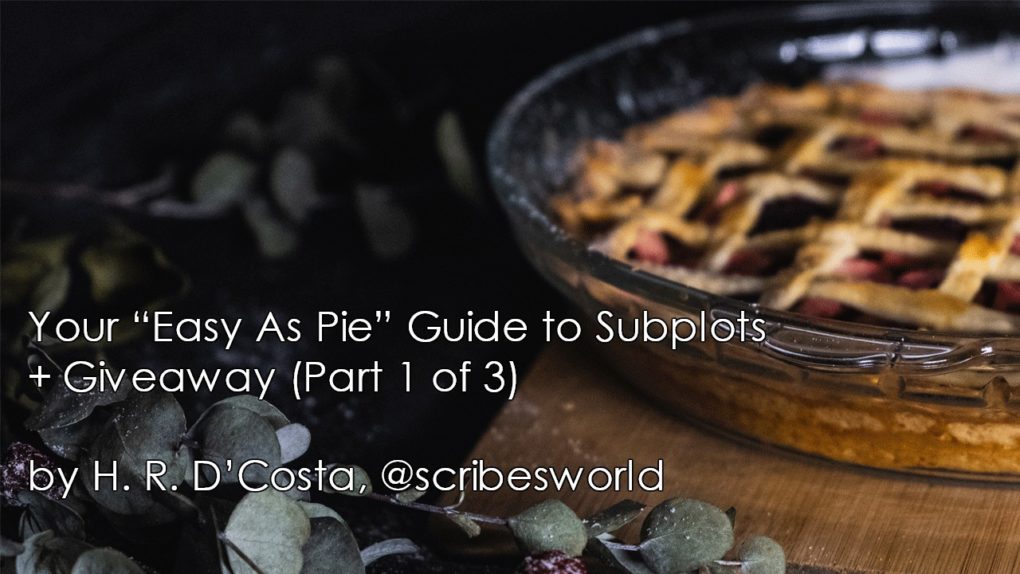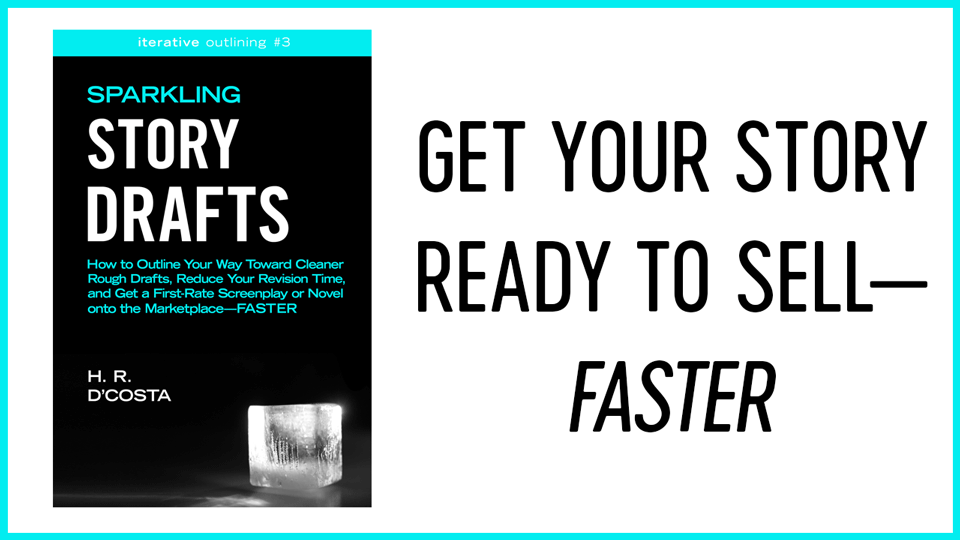by H.R. D’Costa, @scribesworld
Have you ever tried to make a pie crust from scratch?
In my experience, when you press the dough into the pie pan, there’ll be areas where the dough is thick and knobby, almost like the hills of a tea plantation…
…and there’ll be areas where the dough is thin.
So, so thin.
Working with the main plot of your novel can be like that.
There’s only so much of it to go around.
After a certain point, if you try to extract more out of it, you’ll stretch it too thin. You’ll end up with plot points that are bland and repetitious.
Savvy writers recognize this.
They don’t try to extract more than their main plot can give.
Instead, they take a break from the main plot. Like bakers who take scraps of dough to fill in holes in a pie crust, these writers fill their pages with other material.
This is where subplots—secondary stories that are subordinate to the main plot—come in. (Sometimes, a subplot is referred to as the B-story, while the main plot is referred to as the A-story.)
Subplots are one of the best ways to get your novel to the right length, without stretching your main plot too thin.
Of course, you can’t be obvious about it. Then your subplots will feel like filler—and your readers will get bored and start skipping pages.
Not good.
However, readers will be less likely to deem your subplot a stall tactic (even though that’s exactly what it may be)—if you integrate it skillfully into your story.
That’s what this “easy as pie” guide to subplots is all about. With it, you should pick up some tips so that your subplots enhance—rather than detract from—the main plot.
The guide is divided into three parts. Below is a quick overview:
- In Part 1, we’ll cover 5 uses for subplots (you’re reading Part 1 now).
- In Part 2 , we’ll cover how to structure your subplots (plus the golden rule to follow regarding subplots).
- In Part 3, we’ll cover how to weave subplots into your story as well as conduct a subplot “safety check.”
Note: These subplot tips have been adapted from my writing guide Sparkling Story Drafts, which will help you write cleaner rough drafts, reduce your revision time, and get a crazy-good story onto the marketplace—faster. To learn how you could win a paperback copy, see the end of this post.
Ready? Grab a fork, and let’s dig in!
5 Uses for Subplots
If your subplot has an additional function—if it’s not just a stall tactic—then it’s more likely to feel integral to your story…
…and less likely to feel like filler.
Makes sense, right?
So now it’s time to figure out what kind of contribution you want your subplot to make.
Because subplots are flexible, you have multiple options at your disposal. Below are 5 suggestions to get you started.
Use a subplot to:
Elucidate theme or convey character arc. One of my favorite examples is from What Women Want. I love how the subplot between Nick and his daughter demonstrates how much Nick has changed.
Speaking of change…
…in a post on working with theme, Elizabeth mentions exploring “whether the victim in the book had really changed his stripes before he was murdered (as he swore he had).”
Sounds like great subplot material to me!
Increase emotional involvement by highlighting the stakes. Think of the senator’s kidnapped daughter in Silence of the Lambs.
Increase emotional involvement in a subtler fashion by gracing a story with heart. While the hijinks of Home Alone are fun, the heartwarming relationship between Kevin and Old Man Marley elevates the film into something more.
Update readers about reoccurring characters in a series. Fans of a series don’t just invest in the protagonist of the series. They also invest in the supporting cast.
A subplot can provide a great opportunity for fans to reconnect with the characters they love.
Quick tip: to create this kind of subplot, pick a series trope that involves a reoccurring character and build your subplot from there.
Conceal a clue or create red herrings and plot twists. A subplot built around a romance with a new lover yields plot twists in The Verdict, The Devil Wears Prada, and The Dark Knight Rises.
To get a subplot worksheet that conveniently lists all of these uses (plus more!), sign up here.
By the way, there’s nothing wrong with combining multiple functions under the same subplot. In fact, this approach can give your story greater depth and focus, preventing it from turning into one big sprawl.
Now that you’ve sorted out the content of your subplot, it’s time to reflect on its structure. That’s what we’ll cover in Part 2 of this subplot series. Stay tuned!
Win a Paperback Copy of Sparkling Story Drafts
Three different opportunities to win—here’s opportunity #1!
For every post in this series, you have a chance to win a paperback copy of Sparkling Story Drafts ($24.99), which will help you write cleaner rough drafts, reduce your revision time, and get a crazy-good story onto the marketplace—faster.
For a chance to win today, answer this question in the comments: Have you ever used a subplot for one of the purposes listed in this article? If not, what purpose did you use your subplot for?
Elizabeth will randomly select a winner from the comments by Wednesday, January 23.
Note: This giveaway is only open to residents of North America, South America, Europe, and the UK.
Good luck and happy writing!
Author Bio
A graduate of Brown University, H. R. D’Costa (a.k.a. HRD) almost became a lawyer. Twice. But then she realized that although she wanted to be a lawyer, she needed to be a writer. So she dedicated herself to studying films, screenplays, and novels in order to understand why some stories were gripping…while others were easy to walk away from.
Ultimately, she shared her discoveries in eight writing guides, including Sizzling Story Outlines: How to Outline Your Screenplay or Novel, Always Know “What Happens Next,” and Finish Your Rough Draft Without Freaking Out and Story Stakes: Your #1 Writing Skills Strategy to Produce a Page-Turner that Transforms Readers into Raving Fans of Your Screenplay or Novel, which one Amazon reviewer described as “a must-have in your top 10 books on writing.”
For practical, actionable writing tips designed to help you keep readers glued to your pages, visit her website scribemeetsworld.com, which is also home to the Ultimate Story Structure Worksheet (downloaded over 37,000 times by writers from around the world). Get it here.
5 Uses for Subplots from @scribesworld: Click To TweetLattice-style pie by Dilyara Garifullina; Evergreen wreath by Erwan Hesry




Thank you! I am working on a story right now that needs more as the main plot is already stretched. Now I can start working on a subplot to weave throughout. (Which I’ve never intentionally done, so this should be interesting.)
Hi Alex,
So exciting that you’ll be able to apply these tips to your WIP. I hope they’ll help you get it to the right length!
Maybe by the time the third post in this subplot series goes up, you can give us a little update. No pressure :)
Just in case you need one more option, adding another antagonist is also a great way to lengthen a draft.
PS: I’ve been a fan of Elizabeth’s blog for years, and I noticed that you always take the time to leave a thoughtful comment—and first, too. Color me impressed!
I’m using a subplot to add more humor to the book I’m working on.
Oh, that’s a great use for subplots. Thanks for sharing that one, Laura!
One of my favorite uses of subplots is to give updates on recurring characters. The supporting cast is one of the reasons I enjoy reading cozy mysteries, so I’ve tried to do the same in my own with subplots
It’s so much fun to learn what one of those side characters is up to, isn’t it?
In a series, I also love it when reoccurring characters end up driving the plot in one of the later books, e.g. in books #1–#5, they’re a subplot or a trope…but in book #6, they bring the case to the sleuth, or become the victim or prime suspect.
This is really useful. Sub-plots can add a lot of richness to a story, and a strong layer of character development.
So true. Subplots can really take a story to the next level.
From your blog, Margot, it’s clear you have vast knowledge of mysteries. Truly, it’s awe inspiring.
Out of what you’ve read, do you have a favorite example of when a subplot was used for character development? I’d love to hear it!
I realized, as I read this, how timid I was being with the subplot in my current first draft. It has more potential to raise the stakes and add emotional involvement than I was giving it. Thanks,
So glad you’re going bolder with your subplot. From your description, it sounds like this approach is really going to jazz up your story.
Thanks for the tips. I am trying to work some subplots into what I’m writing right now. So this is very timely.
Could this be an example of synchronicity? I love it when that happens.
Good luck weaving your subplots into your WIP, Natalie. (The tips in the third post in this series might be especially helpful with that!)
Character arcs are a great way to weave in a subplot.
I agree! When subplots are used for character development, it’s very satisfying for writers and readers.
I love it when the subplot in some subtle way echoes the main plot, in other words, the subplot resonates with the main story in some way. It’s hard to explain in so many words, which is probably why I’m so bad at creating it. My name for it is parallel planning, but it Hass to be done in a very careful subtle way for it not to look amateurish. It’s common in some British mysteries.
“Parallel planning.” What a great term. Love it!
Another way to think about it might be: the subplot is a microcosm of the main plot.
But I like “parallel planning.” It’s got the alliteration going for it :)
Always looking for more ways to seed in plot twists! This list will be really helpful for generating ideas.
I also like to use subplots to develop secondary characters who might not have much to do with the main plot early on, but will be pivotal in it toward the end.
Yes, it’s definitely fun to hide a plot twist “in plain sight” by using a subplot!
Making a subplot character pivotal toward the end—that’s a great point. I actually talk about that in the second part of this subplot series. Cool, we’re on the same page.
I’ve been focused on the main plot of my current story so much that I don’t much in the way of subplots that aren’t already part of the main plot. I’ll need to go back and fill some in to make the story more complex. thanks for the post.
I’m so glad this article inspired you to go further with subplots. I think they’ll really make a difference!
This is great! Thank you. I am printing this to use.
Teresa
I’m so glad you found this article to be helpful, Teresa. Thanks for taking the time to write a comment.
Hi! I am currently writing my first cozy, well… my first novel in general! I plan to have two main subplots, one that creates a filler side story, that has novella potential and the other is to develop the life and times of one of the main characters. As it is still in outline stages, I am certain a red herring or two will be added. This is a big adventure for me! I am really excited to have found this blog! Thanks for the tips and book recommendations!
It’s awesome that you started writing your first book, Kelly!
It’s also awesome that you found Elizabeth’s blog early on, as a writer. It has many wonderful articles. I know she wrote a really great series of blog posts on writing a cozy mystery. Here’s a link to one of the posts:
https://elizabethspanncraig.com/mystery-writing-tips/writing-cozy-mystery-victim/
And the (forthcoming) posts in this subplot series should be helpful to you, too!
Confession: I’m a plotter who outlines my stories in advance. So I think it’s great that you’re thinking about your subplots while your story is still in the outline stages. It’ll reduce your revision time a lot…which means you’ll have more time to read books and watch movies :)
Best of luck with your grand adventure!!!
I have used subplots, but I’m sorry to say they were not woven into the plot like the nice lattice work on your pie! Can’t wait for the rest of this series.
Maybe your foray into subplots wasn’t as successful as you’d like…but you certainly have a way with words, Amy. Your comment made me grin.
Alas, I cannot take credit for the beauty of the pie. Full credit goes to the photographer. Whether she baked it or not, she made it look gorgeous!
PS: I hope your next subplot foray will yield results more to your liking :)
Great advice!!
I love subplots in romance series where we see past and future couples in action
Oh, that’s a good one. Some time ago, I read a romance novel where the hero from Book A got into fisticuffs with the hero from Book B.
Definitely entertaining!
For Elizabeth’s readers: If you’re reading this, and it’s before Jan 23, it’s not too late! You can still leave a comment, and earn a chance to win a paperback copy of Sparkling Story Drafts.
***
For Elizabeth: Thanks for hosting me! I look forward to returning on Friday :)
Thanks so much for the terrific post, HRD!
I like using at least one subplot to create a red herring to hide the truth from the reader until I’m ready to surprise them with the twist. And the hints they didn’t notice standout during the second reading when they know what they should be looking for.
Sounds like you’re taking a “Sixth Sense” approach to subplots. It certainly worked well for M. Night Shyamalan!
Hope it brings you big success, too, Nicole.
This is really great advice! Thanks for sharing.
http://www.ficklemillennial.blogspot.com
Thanks for reading, Gina. Good luck with the giveaway!
I’ve used subplots to give updates on supporting characters but I’ve also “laid the seeds” for getting to know another character who was in the background. Enough seeds even I was curious about her story and eventually had to start writing it.